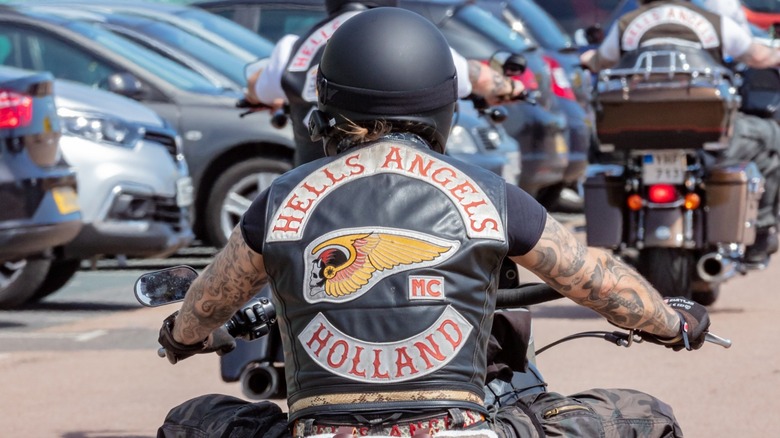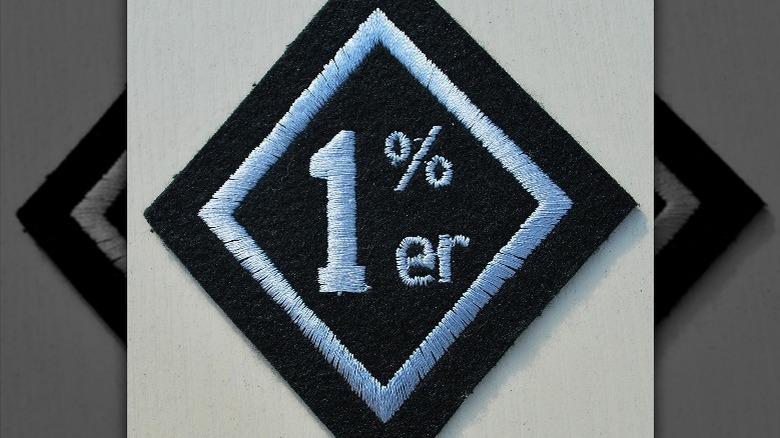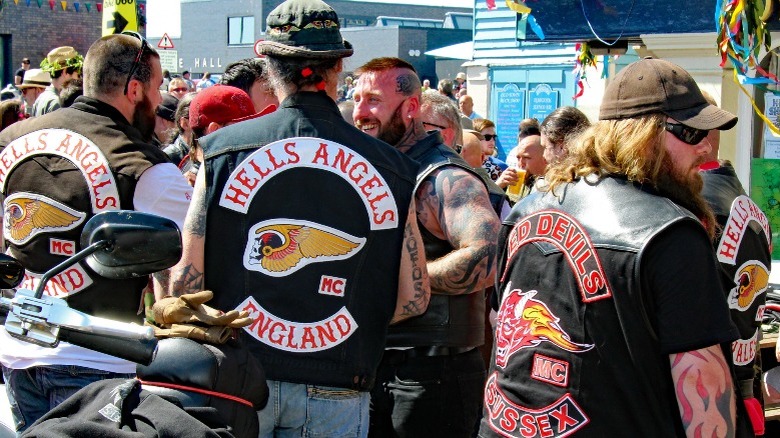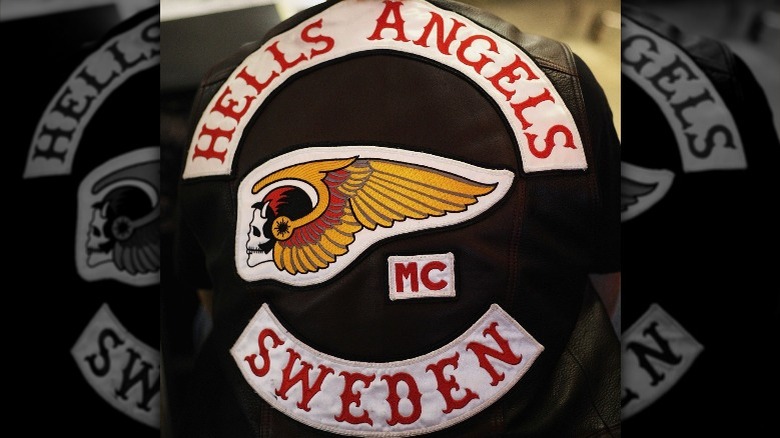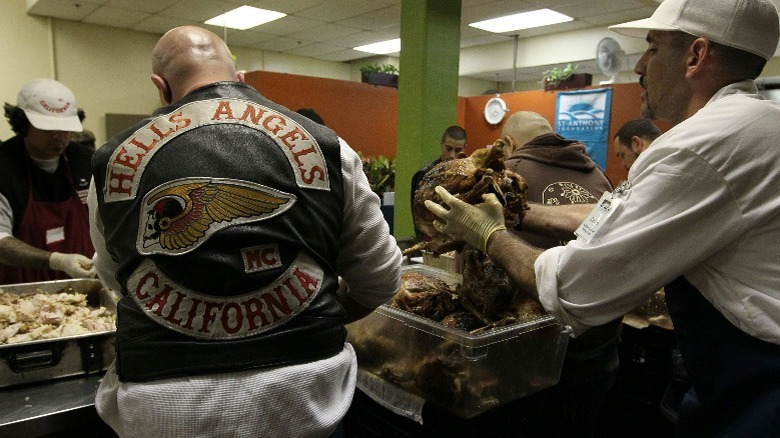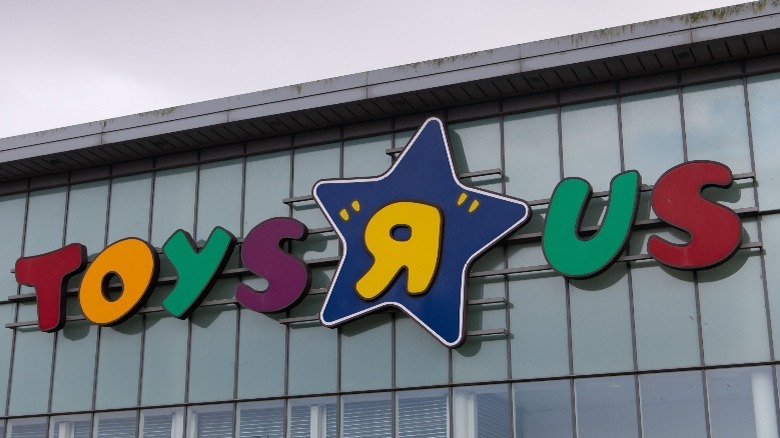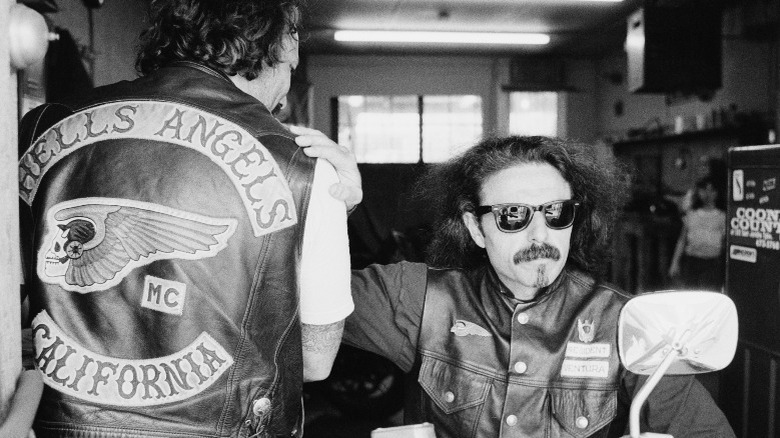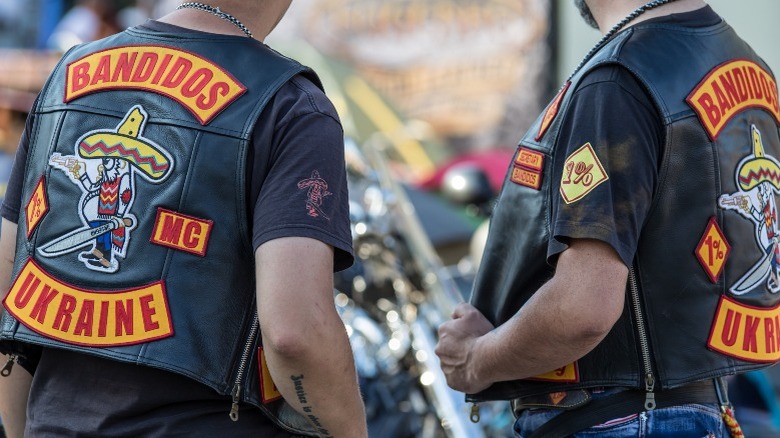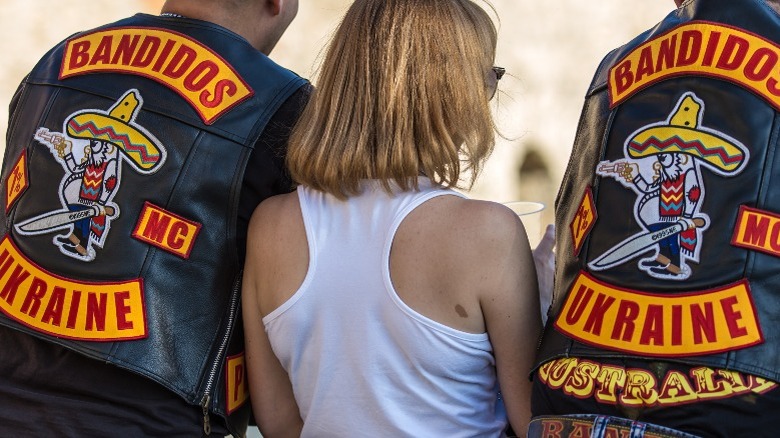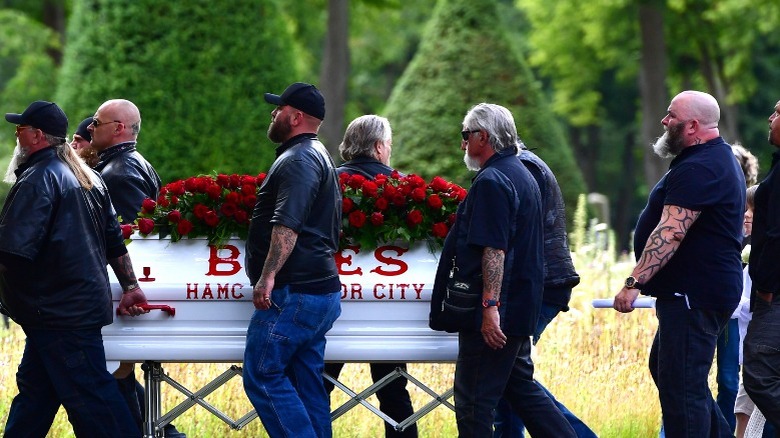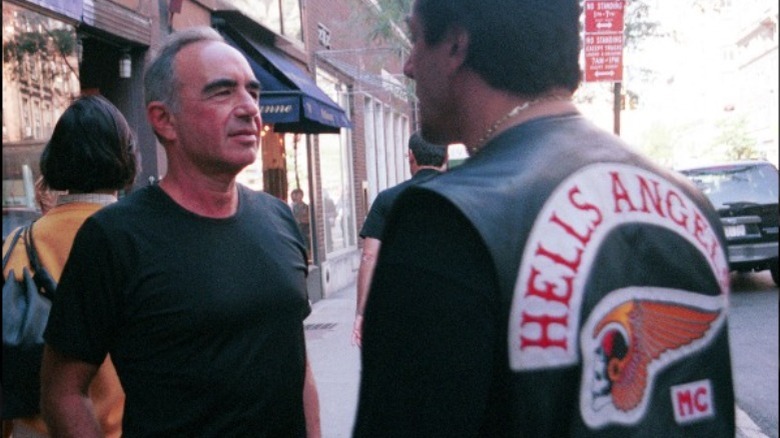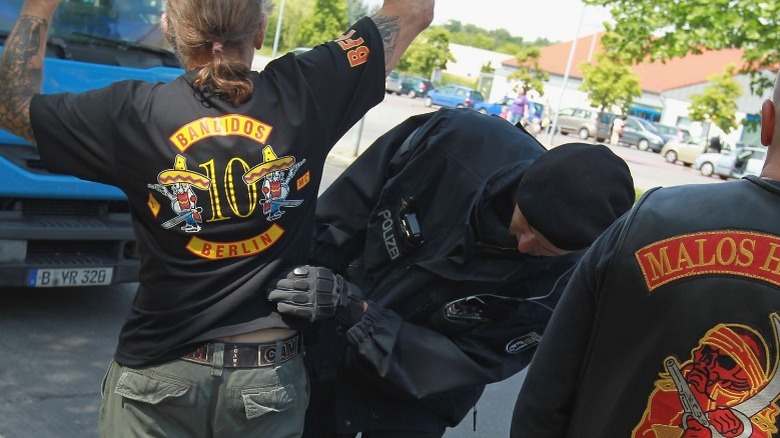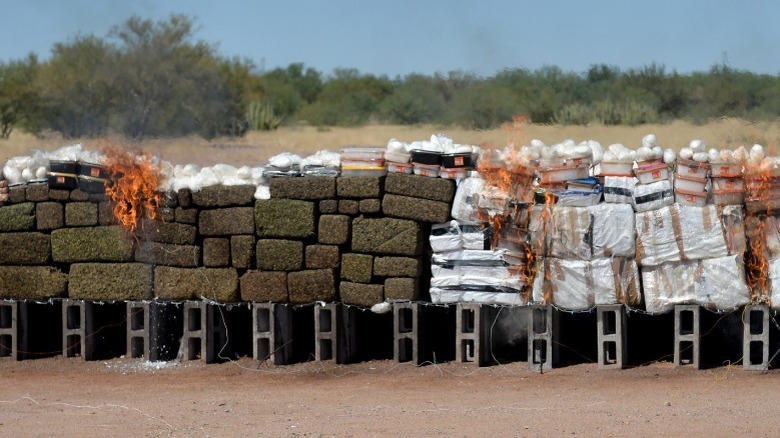The Untold Truth Of The Big Four Motorcycle Gangs
Outlaw motorcycle gangs (OMGs) have garnered a reputation as some of the meanest, toughest, and most violent people on the road. The worst of the gangs are known as the Big Four of OMGs, and they are the Hells Angels MC, the Outlaws MC, the Pagans MC, and the Bandidos MC (per Vox.com). According to William L. Dulaney, the term "outlaw" biker originally just meant a club that was not officially organized under the auspices of the American Motorcycle Association (AMA). Now, however, the term has grown to describe bikers involved in illicit commerce, like selling narcotics and money laundering (per the U.S. Department of Justice).
According to Vox.com, OMG culture is generally thought to have begun in 1947 after the infamous 4th of July riots in Hollister, California. Motorcyclists allegedly started causing trouble and property damage after a locally held race. An article from The New York Times described it as "thirty-six hours of turmoil" when "the cyclists all but took over this town." Newer research has cast doubt on the reliability of those statements, but that was the day OMG culture was born (via William L. Dulaney).
The Big Four of OMGs, the Hells Angels, Outlaws, Pagans, and Bandidos, are infamous for the heights to which they have taken biker gang culture. They are all deadly rivals who have fought and even murdered each other, and the U.S. Department of Justice considers them "highly structured criminal organizations." This is the untold truth of the Big Four of Motorcycle Gangs.
They are all one percenters
While each of the Big Four Outlaw Motorcycle Gangs (OMGs) are independent from each other and have their own unique idiosyncrasies, they do share some commonalities as outlaw gangs. One of the biggest of those is that they are all considered "one percenters." The history of the term "one percenter" is derived from the same Hollister riots that gave birth to OMG culture. According to a 2014 article on OMGs, "one percenter" was first used by the American Motorcycle Association (AMA) in 1947. The AMA argued that the OMG culture put on public display at Hollister was only indicative of one percent of all motorcycle clubs (MCs). The other 99% of MCs were made up of law-abiding citizens who had no interest in drunken riots or vandalism.
Outlaw biker gangs quickly seized on the phrase and started attributing it to themselves. Many of them have stylized patches that bear the name "one percenter" along with their MC's name. Nowadays, the term "one percenter" is synonymous with "methamphetamine production, distribution and sales; prostitution; contract violence; racketeering; and motorcycle theft" (via William L. Dulaney). According to Dulaney, the Hells Angels were the first OMG to use the term to describe themselves, but now nearly every outlaw motorcycle club considers themself to be "one percenters." However, he argues that most "one percenter" clubs do not actually engage in criminal behavior, and the term can really only be accurately applied to a small minority of an OMG's members.
All of the Big Four except the Pagans MC have international chapters
While it might seem standard to associate the outlaw motorcycle gang (OMG) lifestyle with just America, they are now an international phenomenon. According to the Hells Angels MC website, they alone have 467 charters, spread throughout 59 countries and five continents. Their world map shows they have reach in such diverse areas as Namibia, Egypt, Uruguay, New Zealand, and Russia, and they even have prospects throughout Southeast Asia in Indonesia and the Philippines. Their first international chapter was in Auckland, New Zealand, in 1961, and by 1970 they were in Zurich (via their chapter list).
The Outlaws MC has more than 30 international chapters, including at least one in each Czechia, Serbia, Brazil, Montenegro, and Thailand. The Bandidos MC also has a global presence, with charters in Israel, Belgium, Italy, and Ukraine. The Pagans MC is the only one of the Big Four that does not have an international presence, as they prefer to consolidate their control domestically in America (via Crimes of the Big Four Motorcycle Gangs).
Hells Angels and Bandidos fought a war in Scandinavia
The global spread of outlaw motorcycle gangs (OMGs) has brought along with it unfortunate consequences. In the mid-1990s, the Hells Angels MC and the Bandidos MC engaged in a vicious war throughout Scandinavia. It started in 1973, when Willem van Boxtel formed a local biker gang in east-end Amsterdam (via "Angels of Death: Inside the Biker Gangs' Crime of Empire"). By 1977, the gang was given prospect status by the official Hells Angels MC, and in October 1978 they were full fledged members, given the okay by Hells Angels President Sonny Barger himself. Willem immediately set out to do two things: expand his empire and control the drug trade.
However, by late 1993, the rival Bandidos MC had started to set up their own chapters in Scandinavia to compete with the Hells Angels. The Angels were originally okay with a limited Bandido presence, but within a few months the first bloodshed was spilled. Soon, the rival MCs were arming themselves with munitions meant for civilian militias. In June of 1997, the Hells Angels bombed a Bandidos clubhouse, but inadvertently killed a passing civilian (per the Associated Press). This led to a peace agreement between the two that September, that finally ended the bloody war (via the Independent). The war resulted in more than 400 violent incidents, 11 deaths, over 100 injuries, and at least 74 attempted murders. A shocking level of violence for Scandinavia.
They all do charity work
The first thought that comes to one's mind when they think of outlaw motorcycle gangs (OMGs) is probably not charity. Yet, in a surprising twist, all of the Big Four OMGs have chapters that actively participate in giving charity and assisting charitable organizations. Per a report from CNBC, in 2014 a Hells Angels MC chapter from Fresno, California bought 200 bicycles from a local Walmart and donated all of them to a local non-profit, the Poverello House, which helps homeless and indigent families. In 2021, an Outlaws MC chapter in Gulf Coast, Florida, participated in a coat drive that collected more than 1,000 coats and $2,300 for families at Christmas time (via Pensacola News Journal). The coat drive brought Outlaws from throughout Florida, including members from Jacksonville, who came just to take part in the giving.
In 2020, a Pagans MC chapter dropped off lots of donated school supplies at Southside Elementary School in Huntington, West Virginia (via The Herald-Dispatch). The Bandidos MC also has chapters that participate in charity, including one in Spokane, Washington, that donated tons of supplies to a local Salvation Army (per The Spokesman-Review).
However, there are still some who are skeptical of the OMG commitment to actual charity. According to the Chicago Tribune, in 2016, when an Angels chapter in Chicago tried to organize weekly "Bike Nights" to raise money for a local school, authorities immediately sounded the alarm and harassed the bikers during the event.
The Hells Angels MC sued Toys R Us over their Death Head logo
In one of the more bizarre — and comical — bits of Hells Angels MC history, in 2012 they sued the famous American kids retail store Toys 'R' Us, and Yomega, a manufacturer of yo-yos. The lawsuit alleged that Yomega and Toys 'R' Us infringed on the Hells Angels "Death Head" logo, by putting a similar looking logo on their yo-yos and selling them. The Angels asked for "exemplary damages for fraud, malice and gross negligence." Yomega and Toys 'R' Us countersued the Angels in response, saying the Angels had originally obtained the trademark under false pretenses, and therefore it was fraudulent and void. They asked for the Angels' trademarks to be canceled and for them to pay for attorneys fees and court costs. In 2013 the case was settled out of court and the terms were now known. At the time, the Death Head trademark registration was still in effect and the yo-yos were still being sold (via Mintz).
In 2013, the Angels also sued Young Jeezy over the use of the same logo, and it was eventually settled out of court for an undisclosed amount (per TMZ).
Hells Angels members have made over $2 million in settlements with local city governments
Since the 1990s, the Hells Angels MC has filed several lawsuits against local city governments in Colorado and California, making millions in the process. In 1999, Hells Angels members filed a lawsuit against the cities of San Jose and Santa Clara in California. The lawsuit alleged that officers from police departments in these cities had killed three of the Angels' dogs and taken away "truckloads" of items from their houses after searching them (via SFGate). In 2006, the city of San Jose settled for $800,000, the city of Santa Clara settled for $50,000, and the county of Santa Clara settled for $990,000, making the total settlement more than $1.8 million combined.
While the settlements have not been as monetarily high in Colorado, they have been more numerous. In a 2020 article about a new Hells Angels lawsuit against Colorado Police, an article from the The Denver Post noted a 2002 settlement where police paid an Angels member $50,000 after claims of excessive use of force. In 2008, the city settled with a different Angels member for $14,000 after an illegal traffic stop (via The Denver Post). In 2020, five different Colorado police agencies pooled together $25,000 for an Angels member after body cam footage showed them joking about killing him (per The Associated Press).
Entire countries have banned them
You may have been banned from a sports stadium or restaurant for your bad behavior, but can you imagine being banned by an entire country? Well, that's exactly what has happened to both the Bandidos MC and Hells Angels MC in Europe. According to European law enforcement agency Europol, outlaw motorcycle gangs (OMGs) have been steadily increasing their presence and criminal activity throughout Europe since 2005. They claim the OMGs use firearms and grenades to violently enforce their rule, and they are heavily involved in drug trafficking, murder, money laundering, and extortion.
In 1999, Belgium became the first European country to take the step of banning OMGs by declaring the Hells Angels illegal within its borders (per the BBC). A Belgian court ruled the Angels constituted a private militia, which was illegal under Belgian law. In 2019, the Netherlands also banned the Hells Angels throughout the country, citing them as "a danger to public order" (via The Guardian). In 2021, Germany banned the Bandidos MC from the country and dissolved them as an organization (per the Anadolu Agency). Recent raids by police have uncovered numerous illegal items, including firearms and illegal drugs. The Bandidos had been active in Germany since 1999 and expanded heavily in the two decades since.
The Hells Angels MC, Outlaws MC, and Bandidos MC have fought wars in Canada
As part of their international expansion, both the Hells Angels MC and Outlaws MC targeted Canada in the 1970s as a place for new clubs. According to Stephen Schneider in "Iced: The Story of Organized Crime in Canada," the Hells Angels first moved into Canada in 1977, and they started to establish a presence in Quebec, Nova Scotia, and British Columbia. The Outlaws quickly followed and established rival clubs in Ontario and Quebec. Within two years the Outlaws and Angels were at war in both Ontario and Quebec. By the end of 1984, 62 bikers linked to either the Outlaws or Hells Angels had perished in the violence. At this point, the Angels were firmly in control of both British Columbia and Quebec, whereas the Outlaws had staked a firm claim to Ontario.
In 1994, hostilities erupted again between the Angels and another group known as the Alliance, over control of the illicit drug trade (via the Montreal Gazette). By 1999, the Angels had defeated the Alliance, but a new threat quickly emerged. In 2001, the rival Rock Machine MC were "patched over" and joined the Bandidos MC, and they began fighting the Angels. Canadian police finally put an end to the fighting through a few major police operations, codenamed Amigo, Retire, and Springtime. After another series of murders the Bandidos pulled out of Canada in 2008, leaving the Angels the victors (per Vice Canada).
The Bandidos MC and the Hells Angels MC were at war in Germany
Another prominent area of outlaw motorcycle gang (OMG) expansion has been in Germany, where the Bandidos MC and the Hells Angels MC have competed to stake the ultimate claim. According to Spiegel International, Germany was widely considered to be Angels' territory, until 1999 when the Bandidos started to move in. The Angels have defended their turf in Berlin, while the Bandidos have infiltrated neighboring Brandenburg.
The violence has been widespread and several people have been murdered as part of the fighting. In 2008, two members of the Bandidos were sentenced to life in prison for the murder of an Angel (via Deutsche Welle). A month later, three Hells Angels were sentenced to prison for beating up five Bandidos and robbing them (via Deutsche Welle). According to The Local, in October 2009, a Hells Angels sympathizer shot and killed a Bandidos member outside his clubhouse. A month later in November, a group of Hells Angels destroyed the Bandidos' clubhouse during a brawl. The Bandidos retaliated by lobbing a grenade through the Angels' clubhouse a few hours later, but luckily it did not go off and no one was hurt.
In 2010, the Bandidos and Hells Angels supposedly arranged a truce to stop the violence (per Spiegel International). Yet in 2015, another shootout involving the Angels and Bandidos again heightened fears of another OMG war (via The Local).
They have been charged with violating RICO
While most people associate the Racketeer Influenced and Corrupt Organizations Act (RICO) with the mafia and organized crime, prosecutors have started to use it as a tool in an attempt to dismantle outlaw motorcycle gangs (OMGs). According to Middle Tennessee State University, prosecutors use RICO to treat organized crime syndicates as enterprises that can be legally charged with criminal offenses. In one of the first RICO cases against an OMG, in 1985, police in 11 different states collaborated to charge the Hells Angels MC. According to The New York Times, 100 Angels were arrested on charges of both racketeering and drug trafficking. In 2017, multiple Angels were charged with racketeering conspiracy under RICO (via The Department of Justice).
In 2018, two high ranking Bandidos MC members were convicted by a federal jury on RICO charges (per The Department of Justice). In addition, they were also convicted of violent crimes in aid of racketeering (VICAR), extortion, murder, and several other charges. In June 2021, several members of the Pagans MC were charged with RICO offenses and other crimes (via The Department of Justice). Among the accused were the national president of the Pagans, Keith "Conan" Richter, as well as the "President of Presidents," Maurice "Dawg" Guzman. Richter was eventually sentenced to 33 months in prison on weapons charges that October (via NJ.com).
They launder money through pizza parlors
Outlaw motorcycle gangs (OMGs) are involved in a litany of illegal actions, one of the most prominent of which is money laundering. According to the Financial Crimes Enforcement Network (FinCEN), money laundering is a technique used by criminals to manipulate financial systems and assets, by disguising illicitly-gained funds as legitimately-gained funds. According to a 1991 report from the Bureau of Organized Crime and Criminal Intelligence, OMGs used a variety of different sources to launder their illicit money. In the western United States, they used everything from interior decorating companies, to locksmiths, and even pizza parlors. In central U.S., they used beauty shops and horse ranches. And on the East Coast, they used vending machine companies and lawn services. Everywhere, money laundering through real estate was a major problem.
In 2013, several Hells Angels members were convicted of money laundering, along with many other offenses, in South Carolina (per The FBI). And in 2017, the Department of Justice charged two Hells Angels with money laundering in Southern New York.
They are all deeply involved in the narcotics trade
Outlaw motorcycle gang's (OMGs) illegal activities are heavily rooted in illegal drug trafficking. According to the 1991 report from the Bureau of Organized Crime and Criminal Intelligence, illegal narcotics trafficking provided OMGs with their most consistent source of revenue. In the United States, OMGs typically traffic methamphetamine heavily on the west coast, and push cocaine in the Midwest and East Coast. Internationally, they distribute amphetamines in Europe, and cocaine and methamphetamine in Canada. The report estimated that by 1990, OMGs controlled 75% of the methamphetamine trade in the U.S.
According to The Department of Justice, each of the Big Four specialize in drug dealing. The Bandidos MC are involved in cocaine, marijuana and methamphetamine; the Hells Angels MC also distribute LSD, ecstasy and PCP; and both the Pagans MC and Outlaws MC are also centered around cocaine, marijuana, and methamphetamine.
Drug trafficking continues to be a massive source of revenue for OMGs today, but it has also consistently led to the arrests of OMG members. In 2015, eight Bandidos MC members were indicted for drug trafficking in Denver (per Fox). A 2021 raid on the Outlaws MC in Kingston, Ontario, turned up large amounts of both fentanyl and cocaine (per Global News).
If you or anyone you know is struggling with addiction issues, help is available. Visit the Substance Abuse and Mental Health Services Administration or contact SAMHSA's National Helpline at 1-800-662-HELP (4357).
